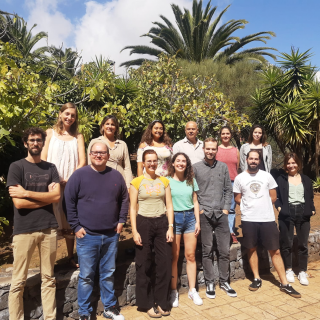Bibcode
Verro, K.; Trager, S. C.; Peletier, R. F.; Lançon, A.; Gonneau, A.; Vazdekis, A.; Prugniel, P.; Chen, Y. -P.; Coelho, P. R. T.; Sánchez-Blázquez, P.; Martins, L.; Arentsen, A.; Lyubenova, M.; Falcón-Barroso, J.; Dries, M.
Referencia bibliográfica
Astronomy and Astrophysics
Fecha de publicación:
4
2022
Revista
Número de citas
72
Número de citas referidas
58
Descripción
We present the third data release (DR3) of the X-shooter Spectral Library (XSL). This moderate-to-high resolution, near-ultraviolet-to-near-infrared (350-2480 nm, R ∼ 10 000) spectral library is composed of 830 stellar spectra of 683 stars. DR3 improves upon the previous data release by providing the combined de-reddened spectra of the three X-shooter segments over the full 350-2480 nm wavelength range. It also includes additional 20 M-dwarf spectra from the ESO archive. We provide detailed comparisons between this library and Gaia EDR3, MILES, NGSL, CaT library, and (E-)IRTF. The normalised rms deviation is better than D = 0.05 or 5% for the majority of spectra in common between MILES (144 spectra of 180), NGSL (112/116), and (E-)IRTF (55/77) libraries. Comparing synthetic colours of those spectra reveals only negligible offsets and small rms scatter, such as the median offset(rms) 0.001 ± 0.040 mag in the (box1 − box2) colour of the UVB arm, −0.004 ± 0.028 mag in (box3 − box4) of the VIS arm, and −0.001 ± 0.045 mag in (box2 − box3) colour between the UVB and VIS arms, when comparing stars in common with MILES. We also find an excellent agreement between the Gaia published (BP − RP) colours and those measured from the XSL DR3 spectra, with a zero median offset and an rms scatter of 0.037 mag for 449 non-variable stars. The unmatched characteristics of this library, which combine a relatively high resolution, a large number of stars, and an extended wavelength coverage, will help us to bridge the gap between the optical and the near-IR studies of intermediate and old stellar populations, and to probe low-mass stellar systems.
The spectra are only available at the CDS via anonymous ftp to cdsarc.u-strasbg.fr (ftp://130.79.128.5) or via http://cdsarc.u-strasbg.fr/viz-bin/cat/J/A+A/660/A34
Proyectos relacionados

Huellas de la Formación de las Galaxias: Poblaciones estelares, Dinámica y Morfología
Bienvenida a la página web del g rupo de investigación Traces of Galaxy Formation. Somos un grupo de investigación amplio, diverso y muy activo cuyo objetivo principal es entender la formación de galaxias en el Universo de una manera lo más completa posible. Con el estudio detellado de las poblaciones estelares como bandera, estamos constantemente
Anna
Ferré Mateu